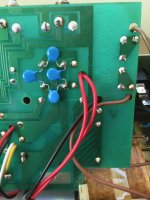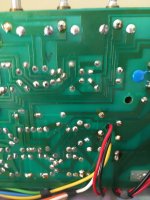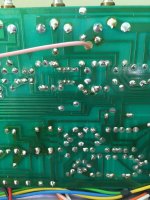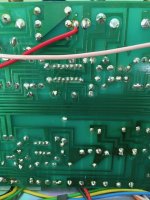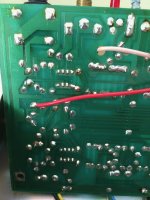plugs are males jacks are females, you stick a plug into a jack....don't giggle thinking about that...just check the input jack,please!
Main input has "shorting" type of jack socket. The measured resistance across is 0.5 ohm, which can be considered as pure short.
Last edited:
i'll wait for pic's of the solder side, i'll wager there's either a broken control, funky solder or something still amiss with the send return jacks..
after that confirming that the low voltage supply is ok would be next on my list.
after that confirming that the low voltage supply is ok would be next on my list.
Ok, will shoot some detailed pics of the solder site.
Send/Return were cleaned (only return has shorting jack), but not resoldered.
Low voltage power supply was checked and partially rebuild (new 100uF caps, paired 15V zeners, approx +/- 16.2 V on both rails).
Send/Return were cleaned (only return has shorting jack), but not resoldered.
Low voltage power supply was checked and partially rebuild (new 100uF caps, paired 15V zeners, approx +/- 16.2 V on both rails).
Last edited:
i'm stopping for a scotch break....
Thank you and enjoy your scotch.
some of the photos are not well focused but one thing that stands out is some of the traces have been jumpered, not a good sign!
i take it the jack board on the back of the amp is still installed?
i take it the jack board on the back of the amp is still installed?
Do you mean the "jumper" near the red LED? That is my work. The track was cracked, scraped down the lacquer and bridged it.
The back jacks are still connected.
The back jacks are still connected.
just be careful...as someone who does a lot of repair work blanket solutions means that you never learn the details of the fault and that would make me lose sleep and drink more scotch...
considering some jumpers have been employed in previous repairs is it possible the board was flexed enough to develop a crack (try backlighting it see if you notice any cracks in the phenolic)
and a magnifying glass does help in exposing faulty solders.
considering some jumpers have been employed in previous repairs is it possible the board was flexed enough to develop a crack (try backlighting it see if you notice any cracks in the phenolic)
and a magnifying glass does help in exposing faulty solders.
The PCB seems to be good. No cracks.
---
Regarding the E.Q. push/behaviour without the E.Q. engaged the input has higher sensitivity. Another indication that the issue is in the preamp part.
---
Regarding the E.Q. push/behaviour without the E.Q. engaged the input has higher sensitivity. Another indication that the issue is in the preamp part.
@turk 182 what jumpers exactly are we speaking here?
For example the jumper between c33 leg and L6 point is there from factory.
For example the jumper between c33 leg and L6 point is there from factory.
ok i stand corrected on the jumpers.
so now it's down to signal tracing stages and confirming local grounds eh.
quick question if you connect to the fx loop return and short the cable do things go quiet?
so now it's down to signal tracing stages and confirming local grounds eh.
quick question if you connect to the fx loop return and short the cable do things go quiet?
Last edited:
Well that will be "fun", because currently I do not have oscilloscope. And my audio probe small active pc speakers were not sensitive enought to track the hum (already tried that).
So maybe the first step will be confirming local grounds.
So maybe the first step will be confirming local grounds.
- Home
- Live Sound
- Instruments and Amps
- Marshall Reverb 75 (5275) - Hum issues

